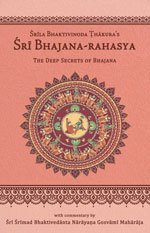Bhajana-Rahasya
by Srila Bhaktivinoda Thakura Mahasaya | 2010 | 123,965 words
The Bhajana-rahasya (including commentary): a compilation of verses describing the mercy of the eight pairs of names (Yugala-nama) of the Maha-mantra. It is considered a supplement to the Shri Harinama-cintamani. The author, Srila Bhaktivinoda Thakura, has selected verses that serve to guide the Sadhaka in awakening his eternal identity as a servan...
Introduction to the Rahasya
[Originally written in Bengali by Śrīla Bhaktisiddhānta Sarasvatī Ṭhākura. The English is translated from the Hindi GVP edition.]
Śrī Bhajana-rahasya is compiled by Śrīla Bhaktivinoda Ṭhākura Mahāśaya. He has collected into the form of a book several confidential hints from his own method of bhajana to guide sincere sādhakas who are performing bhajana under his direction. Some years ago, this destitute person observed him performing bhajana. He was constantly reciting and relishing verses such as the ones in this book, thus becoming overwhelmed with bhagavat-prema.
For sādhakas whose faith is on the neophyte platform, the system of arcana is provided. Many people are unable to understand the distinction between arcana and bhajana and therefore use the word bhajana to refer to arcana. One can practise bhajana by performing the nine kinds of devotion (navadhā-bhakti). Because arcana is included within navadhā-bhakti, it is also considered a part of bhajana. There is a difference between complete bhajana and partial bhajana. Arcana means to worship the deity with awe and reverence; that is, with knowledge of the Supreme Lord’s divine majesty and by observing etiquette. It is also arcana to serve the Lord with various paraphernalia according to rules and regulations and with the mundane conception of identifying oneself with the material body. In service rendered with intimacy and a sense of possessiveness (viśrambha-sevā), the harsh rays of awe and reverence are still apparent to a small degree, but no one can refuse the excellent sweetness of its cool, pleasant moonbeams. Therefore, a brief arcanapaddhati has been added at the end of this book.
Within the framework of this book, the secret meaning of bhajana is given in a way that captivates the heart. In the process of arcana, one remains more or less entangled in one’s relationship with the gross and subtle body. In the realm of bhajana, however, the sādhaka passes beyond both the gross and subtle bodies to directly serve Śrī Bhagavān. The transcendental sentiments that others perceive in great personalities (mahāpuruṣas), who perform bhajana and who are completely free from all kinds of material designations, are not worldly or illusory. Due to being directly within the proximity of the nondual Supreme Absolute Truth (advaya-jñāna para-tattva), who is beyond perception, they experience the transcendental sentiments of sevā that are beyond the range of material senses and material time.
Rahasya means ‘a profound subject that is instructed by the guru and that is required to be known by those with great faith’. As a result of first receiving spiritual instructions and then performing viśrambha-sevā, which is the third among the sixtyfour limbs of sādhana-bhakti mentioned in Bhakti-rasāmṛta-sindhu, a devotee begins to follow the path of sādhus. To do so is to cultivate bhajanarahasya. Niskiñcana-bhaktas, who are absorbed in bhagavadbhajana, become freed from material bondage. They therefore also become completely freed from the association of those bound by worldly desires. At that time, the inclination to engage in service throughout the twentyfour hours of the day (aṣṭa-kālīya-sevā) awakens in their hearts. Pure devotees who are intent on rendering sevā consider the association of nondevotees, who are attached to either enjoyment or renunciation, to be an obstacle in the attainment of their desired goal. Such anyābhilāṣīs (those with desires other than to serve Śrī Kṛṣṇa), karmīs and jñānīs do not have a taste for bhajana-rahasya. Therefore, due to being unqualified to enter the realm of bhajana, which is transcendentally illuminated by the eight divisions of the day, they do not revere this book.
When the day and night are divided into eight parts, each part is known as a yāma. There are three yāmas during the night, three during the day, one at dawn and one at dusk. Only pure Vaiṣṇavas are able to perform kṛṣṇa-bhajana with onepointed niṣṭhā in all respects and at all times. Such continuous bhajana is not possible as long as one’s gross and subtle material conceptions of ‘I’ and ‘mine’ remain. The living entities will not be liberated from this conditioning if they attribute mundane conceptions to matters related to Śrī Hari. Vaiṣṇavas dedicated to bhajana who have achieved their pure identity (śuddha-svarūpa) remain ever intent on serving Śrī Kṛṣṇa.
The eight verses of Śrī Śikṣāṣṭaka, composed by Śrī Gaurasundara, contain transcendental sentiments favourable to bhajana throughout the eight periods of the day. The eleven verses of Śrī Rūpa Gosvāmī’s Śrī Rādhā-kṛṣṇayor-aṣṭa-kālīya-līlā-smaraṇa-maṅgalastotram[1] and the poetry that expresses longing for aṣṭa-kālabhajana composed by all the mahājanas who follow him, prescribe continuous bhajana. Upon becoming completely free from mundane conceptions of time, place and recipient, the servant of the spiritual master should constantly study Śrī Bhajana-rahasya.
The servant of the devotees of Śrī Hari,
Dāsa Śrī Siddhānta Sarasvatī
13 November, 1927
Kānpur
